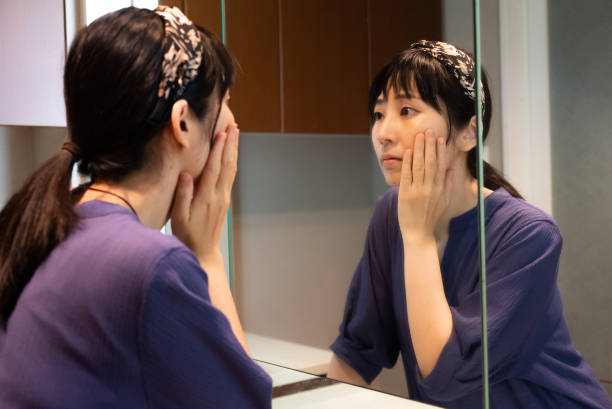
While there is mental health stigma about many mental health disorders, one that still gets the most misunderstanding seems to be OCD (Obsessive-Compulsive Disorder). When you see shirts with phrases like “I have OCD – Obsessive Christmas Disorder” or hear people proudly say, “I am so OCD – I love my house clean,” it perpetuates the mis-profiling of the true nature of OCD and leads to isolation for many people who suffer from it. If you have wondered, “Do I have OCD?” you might be curious to know how OCD manifests and how to tell it apart from strong preferences. Let’s dive into the cycle of OCD and all the different subtypes to learn more.
Those who have OCD experience fears and compulsions and participate in compensatory behaviors and rituals to try to alleviate their symptoms. Fears such as forgetting or losing items may result in triple-checking for things (“Did I grab my wallet? Did I turn the oven off?”), or making multiple notes. Fears about germs and contamination may result in excessive hand-washing, avoiding touching common surfaces, preventing items from touching one another, and more. Intrusive taboo thoughts may be counteracted with rituals of penance and/or distraction, such as repeating phrases, praying, counting, or doing good deeds to counteract the perceived “bad deeds” of these thoughts. People with OCD can know that thoughts and compulsions are debilitating and want to stop but do not feel able to do so. Participating in compulsion isn’t a positive and joyful experience but rather a way to relieve some anxiety around the obsession in question. These behaviors and patterns can have a detrimental impact on the person’s life, taking their time and energy away from what they’d rather be doing or thinking about.
What is OCD?

Obsessive-Compulsive Disorder is a mental health condition characterized by recurring, unwanted thoughts (obsessions) that lead to uncomfortable emotions, including but not limited to anxiety, disgust, fear, and distress. In response to the intolerable emotions, one will engage in repetitive behaviors or mental acts, which are called compulsions, in the hope of either reducing the uncomfortable emotion or falsely believing that the compulsions can prevent a feared outcome from coming true. These obsessions and compulsions can significantly interfere with daily activities, relationships, and overall quality of life.
As you seek help for your OCD, you will find that there is a long list of subtypes. While the most common subtypes are Contamination OCD, Harm OCD, Just Right OCD, or Relationship OCD, there are less-known (and often reported to be more stigmatized) subtypes such as SO-OCD, Pedophile OCD, Existential OCD, PostPartum OCD, or Sensorimotor OCD. These types of OCD are accompanied by taboo thoughts that can make seeking treatment feel terrifying. The goal of assessment and seeking therapy for OCD will include identifying the subtype of your OCD. However, identifying the subtype is not the end goal because, in the end, all these subtypes are part of OCD, and seeking ERP (Exposure and Response Prevention) therapy is the gold standard when it comes to treatment.
3 Ways to Get a Handle on Your OCD
1) Seek Professional Help:

A mental health professional will not only help you to determine which subtype(s) of OCD you have but also assist you in creating and implementing a treatment plan. Cognitive Behavioral Therapy (CBT) is considered the gold standard for treating OCD; the form of this therapy that is used most often is Exposure and Response Prevention (ERP). A therapist specializing in OCD can help you understand the underlying patterns of your obsessions and compulsions, develop coping strategies, and gradually expose you to feared situations or thoughts in a controlled manner, allowing you to learn healthier ways of responding.
You might wonder how you will feel when you first begin seeing an OCD specialist. The truth is that OCD is not something you can just wish away or cease experiencing with enough willpower. Coming to terms with your diagnosis is about understanding what OCD is and also giving yourself grace for the times in the past when you felt shame and frustration about your obsessions and compulsions. This will be a time of discovery and of you considering how you have coped with your OCD thus far and how to be open to new methods and tactics. Your mental health care provider will be able to support you as you work through your thoughts and emotions about your diagnosis.
Implementing a treatment plan for your OCD will take some time, patience, and persistence; there are effective methods of treatment that can feel daunting to take on but come with immense benefits. Exposure Response Prevention therapy is about gradually exposing the patient to environments or situations that will trigger their obsessions and compulsions, but doing so in a safe environment. What is very beneficial about ERP is that it’s not about avoiding these triggers; it is impossible to completely remove these situations from your life. Instead, it teaches you how to handle situations that are bound to occur. Exposure to fears (such as mess or germs, which are common OCD triggers) can happen gradually over time, through experiencing contact with surfaces like door handles or spending time in disarray. These are tactile, hands-on exposures. ERP can also be used to address intrusive thoughts and compulsions, like thoughts of self-harm or of harming others in some way. Whether you are being exposed to something physical in your environment or a persistent thought, you can practice your response and learn to adjust it over time to something that is manageable for you.
Truly feeling safe enough to discuss the more taboo aspects of OCD is something we often hear from our patients who come to us for OCD therapy in Woodland Hills. It is important for you to recognize that a licensed mental health professional will understand how OCD manifests and wants to help you cope with your symptoms. Hiding them away because you are embarrassed won’t help you adjust your thought patterns. This is not a case of ignoring something until it goes away.
2) Practice Mindfulness and Relaxation Techniques:

Mindfulness meditation, deep breathing exercises, and progressive muscle relaxation are just a few examples of techniques that can help calm the mind and reduce anxiety levels. By cultivating present-moment awareness and learning to observe your thoughts without judgment, you can begin to disengage from the cycle of obsessive thinking and compulsive behaviors. In this way, you can begin to feel that you have a handle on your OCD.
No amount of relaxation is going to make your OCD go away. However, these techniques can reduce your overall stress. Stress and anxiety make us more susceptible to our triggers and can make our triggers come on stronger than they might if we were calmer. For example, if you tend to find that a messy environment triggers an obsessive need to organize or a compulsion to rearrange the things around you, then you know that mess is a trigger. If you are already having an anxious day, and then you spill something or enter a cluttered environment, you might find yourself faced with distress. However, if you are relatively calm and encounter the same situation, you may feel more able to cope with what is going on and make a plan of action that doesn’t derail or monopolize your day.
Find ways to integrate meditation, relaxation, and mindfulness into your everyday life. Start or end your day (or do both) with a relaxing walk, perhaps while listening to a meditation or a relaxing podcast. Take time to sit or lay down quietly and focus on your breath at some point during the day – where can you schedule that in? Remember that conscientious efforts pay off. If you have to write it in your day book, set an alarm on your phone, or leave sticky notes where you’ll see them, do it. Over time, these behaviors become habits; you will find that you feel a difference when you haven’t set aside time to decompress and connect to yourself.
In mindfulness practice, the goal is to observe what is happening in real-time without holding self-judgment or guilt about it. This practice can come especially in handy for those with OCD, as intrusive thoughts have a way of compounding and derailing goals and plans. Spiraling about thoughts, trying to determine what they mean, how they reflect upon you as a person, and how they are going to impact your day, gets you trapped in a cycle about your thoughts. Mindfulness, on the other hand, allows you to notice a thought without adopting it or valuing it as a reflection of your goodness, your worth, your morals, and so on.
If you find that you struggle to find a routine that supports your mindfulness and relaxation techniques, try recruiting a friend or other loved one who can either remind you of your intentions or join in on these exercises with you. Someone you live with may be able to take on something in your daily life so that you have the time and space to listen to a meditation or do some deep breathing on your own. If you want to approach someone for help, remember that you are recruiting assistance to deal with a problem. You may feel like you’re asking a lot of someone when in actuality, they are happy to sit down and see where they have room to assist you. Seeking support isn’t the same as presuming it; you are not selfish for leaning on someone you trust, the same way you would want that person to lean on you for help in return.
3) Build a Support Network:

Living with OCD can be isolating, but you don’t have to face it alone. Surround yourself with understanding and supportive individuals who can offer empathy, encouragement, and practical assistance when needed. Whether it’s friends, family members, support groups, or online communities, connecting with others who share similar experiences can provide validation and reassurance that you’re not alone in your struggles.
Support groups and online communities for people who have OCD can serve not only as a safe space in which to open up about your struggles as they arise but also to learn from the people around you and to sustain your own confidence in being of service to others. The people in your life who love and support you, but do not have OCD, might not know what an undertaking it might be to try a new activity or change a specific habit. Being accompanied or cheered on by people who have been in your shoes can give you the security and motivation you need.
The people in your life who do not have OCD can not only serve as reminders that you are more than your OCD diagnosis but can help you when you’re navigating extra challenging situations. For example, if you have a hard time advocating for yourself or expressing your needs in public, such as when out for a meal or joining an activity, someone who is there to bolster you can make all the difference. Where you might worry that you’ll get stuck on a thought, you can know that the person with you will be there to support your plans and speak up when necessary.
Things that are made challenging by your OCD might feel discouraging, but a good support network can help you work through those tasks, chores, goals, and routines. For example, buddying up with someone who can help you remember your affirmations or your plan of how to approach triggering situations can make tackling real-world triggers less daunting. That person can also be there to celebrate with you when you succeed or even the fact that you tried at all. A support network is likely to take note of the steps you take, the milestones you reach, and the ways your behavior has changed. When you are overwhelmed by your own thoughts, you can miss some of these achievements or wonder how effective your new behavior patterns are.
In addition to seeing and supporting the work you are doing, other people can also note times when your symptoms seem to be exacerbated. This isn’t about monitoring and policing you; what this kind of support system can do is help you take note of situations from a more neutral point of view and also help you affirm what you are experiencing by validating the experience outside your mind.
Through my years as an OCD counselor in Woodland Hills, I have seen patients for both in-person and online OCD therapy manage their symptoms and move forward in their lives. Obsessive-Compulsive Disorder evolves over a lifetime as you. Some people find that their OCD symptoms change with age; others find that it is more about stress levels and what is going on in their lives. If you feel you may have OCD, the best thing to do is to reach out to a mental health professional for a diagnosis and a plan. Step by step, you can adjust your thoughts and behaviors.
OCD Treatment in Woodland Hills, CA
OCD is one of the most misunderstood diagnosis causing mislabeling and at times delay in correct diagnosis. Per IOCDF’s research, it can take 7 to 14 years before correct diagnosis is given. Therefore, here at Embracing You Therapy, we highly value our trainings in OCD to provide the best service to our community. To understand the OCD cycle and how create changes in your life to better mangae, you need to work with our OCD specialist here in Woodland Hills or virutally for OCD treatment that utilizes ERP, CBT, ACT, and mindfulness techniques. Contact us today for your complimentary 20-minute phone consultation with our Admin Team today!




